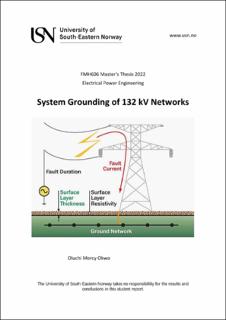| dc.description.abstract | As the use of other renewable energy sources such as wind increases to reduce the carbon dioxide emission into the environment, the transmission and distribution network increase, and the Local Vestfold and telemark region is not an exception. However, this challenges system operations, planning, and protection to ensure that system reliability is sustained, especially during short circuit faults due to increased load on the transmission lines. Quick circuit analysis of a power system is of paramount importance as this provides the voltage and current needed in the design and rating of electrical equipment.
The project topic (System grounding of 132Kv network) focuses on the overvoltage impact of this development on the two primary grounding methods Compensated and direct (centralized and distributed)during single-phase to ground fault of a network in a radial system for both symmetrical and unsymmetrical transmission lines and how a single-phase fault voltage and current impact on one side of a transformer station is dependent on the type of grounding method, no of winding in the transformer unit and the winding connections.
This was validated using the powerfactory to design a typical Vestfold and telemark 132kv network with an external infeed. The simulation was carried out with both compensated and direct grounding methods for transposed and un-transposed transmission lines.
The research result proves that compensated grounding shows a higher overvoltage of 1.760pu with a reduced fault current of 0.003kA for transposed transmission lines, while the fault current was doubled to 0.006kA when the transmission line is un-transposed. Overvoltage at the end of a radial transmission line was lower (1.712p.u) compared to 1.760p.u at the middle of the radial line. Direct grounding overvoltage of 1.30p.u was recorded with a high fault current value of 1.129kA. Similarly, distribution of the compensated Peterson coil and direct grounding to several stations on the network reduces this overvoltage in both grounding methods. Still, it contributes significantly to the double fault current recorded for the directly grounded system. | |
